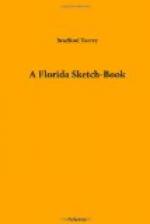I still minded the birds and flowers, I for the most
part forgot my botany and ornithology. In the
cool of the day, then (the phrase is an innocent euphemism),
I climbed the hill, and after an hour or two on the
plateau strolled back again, facing the sunset through
a vista of moss-covered live-oaks and sweet gums.
Those quiet, incurious hours are among the pleasantest
of all my Florida memories. A cuckoo would be
cooing, perhaps; or a quail, with cheerful ambiguity,—
such as belongs to weather predictions in general,—would
be prophesying “more wet” and “no
more wet” in alternate breaths; or two or three
night-hawks would be sweeping back and forth high above
the valley; or a marsh hawk would be quartering over
the big oatfield. The martins would be cackling,
in any event, and the kingbirds practicing their aerial
mock somersaults; and the mocking-bird would be singing,
and the redbird whistling. On the western slope,
just below the oatfield, the Northern woman who owned
the pretty cottage there (the only one on the road)
was sure to be at work among her flowers. A laughing
colored boy who did chores for her (without injury
to his health, I could warrant) told me that she was
a Northerner. But I knew it already; I needed
no witness but her beds of petunias. In the valley,
as I crossed the railroad track, a loggerhead shrike
sat, almost of course, on the telegraph wire in dignified
silence; and just beyond, among the cabins, I had my
choice of mocking-birds and orchard orioles.
And so, admiring the roses and the pomegranates, the
lantanas and the honeysuckles, or chatting with some
dusky fellow-pilgrim, I mounted the hill to the city,
and likely as not saw before me a red-headed woodpecker
sitting on the roof of the State House, calling attention
to his patriotic self—in his tri-colored
dress—by occasional vigorous tattoos on
the tinned ridgepole. I never saw him there without
gladness. The legislature had begun its session
in an economical mood,—as is more or less
the habit of legislatures, I believe,—and
was even considering a proposition to reduce the salary
and mileage of its members. Under such circumstances,
it ought not to have been a matter of surprise, perhaps,
that no flag floated from the cupola of the capitol.
The people’s money should not be wasted.
And possibly I should never have remarked the omission
but for a certain curiosity, natural, if not inevitable,
on the part of a Northern visitor, as to the real
feeling of the South toward the national government.
Day after day I had seen a portly gentleman—with
an air, or with airs, as the spectator might choose
to express it—going in and out of the State
House gate, dressed ostentatiously in a suit of Confederate
gray. He had worn nothing else since the war,
I was told. But of course the State of Florida
was not to be judged by the freak of one man, and
he only a member of the “third house.”
And even when I went into the governor’s office,
and saw the original “ordinance of secession”




